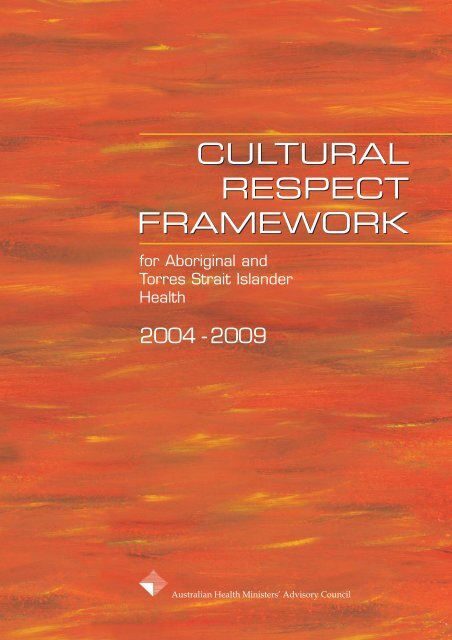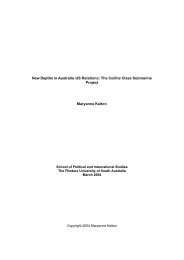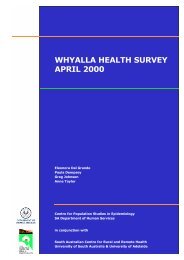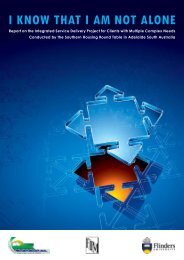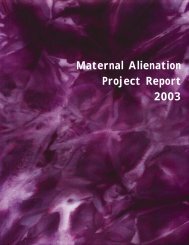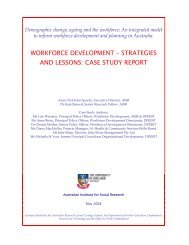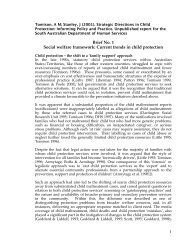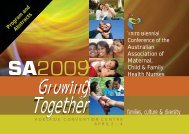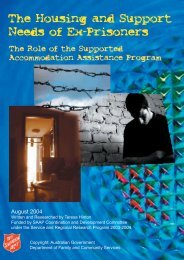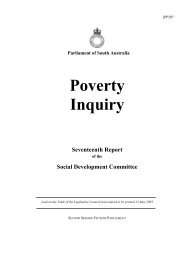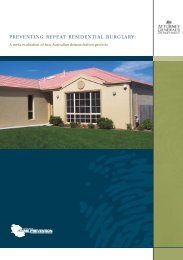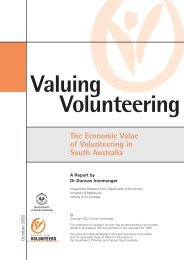cultural respect framework cultural respect framework - SA.Gov.au
cultural respect framework cultural respect framework - SA.Gov.au
cultural respect framework cultural respect framework - SA.Gov.au
- No tags were found...
You also want an ePaper? Increase the reach of your titles
YUMPU automatically turns print PDFs into web optimized ePapers that Google loves.
CULTURALfor Aboriginal andTorres Strait IslanderHealth2004 - 2009RESPECTFRAMEWORK
CULTURAL RESPECT FRAMEWORKFOR ABORIGINAL AND TORRES STRAITISLANDER HEALTH2004 - 2009Prepared by theAustralian Health Ministers’ Advisory Council’sStanding Committee on Aboriginal and Torres Strait Islander HealthWorking Party (Comprising the Northern Territory, Queensland and South Australia)Published by the Department of Health South AustraliaMarch 2004
ForewordThe standard of health of our Aboriginal and Torres Strait Islander population isconsiderably poor by comparison with other Australians. Although improvementshave been made in recent years the gap in life expectancy for Aboriginal and TorresStrait Islander peoples compared to the rest of the population remains significantlyhigh and in marked contrast to other comparable countries. Many c<strong>au</strong>ses of ill healthand premature death are preventable, yet a number of barriers continue to restrictAboriginal and Torres Strait Islander peoples’ access to an equitable, quality healthsystem.Commissioning of this Framework by the Australian Health Ministers’ AdvisoryCouncil (AHMAC) to its subcommittee, the Standing Committee on Aboriginal andTorres Strait Islander Health (SCATSIH) led to the formation of a working groupcomprising representatives from the Northern Territory, Queensland and SouthAustralia responsible for managing the process. Widespread consultation hasoccurred in the development of the Cultural Respect Framework for Aboriginal andTorres Strait Islander Health, with an early focus on agreement to the concept anddefinition of “Cultural Respect”.The Cultural Respect Framework has been developed as a guiding principle in policyconstruction and service delivery for utilisation by jurisdictions as they implementinitiatives to address their own needs, in particular mechanisms to strengthenrelationships between the health care system and Aboriginal and Torres Strait Islanderpeoples. Right from the outset there was recognition of the importance for theFramework to link with other key documents identified in the bibliography, inparticular the National Strategic Framework for Aboriginal and Torres Strait IslanderHealth, 2003 and the Aboriginal and Torres Strait Islander Health Workforce NationalStrategic Framework, 2002.I would like to take this opportunity to thank the many people involved in developingthis Framework, in particular the Aboriginal and Torres Strait Islander representativesof a range of health organisations who freely provided input throughout the process.Jim BirchChairSCATSIHMarch 20043
such as diabetes, hypertension, and a range of communicable diseases. 5 Rates of nonfatalinjury and self-harm, mental illness and harmful substance use are also higher. 6In the four key mortality categories that account for the majority of excess deaths, thecontrasts are stark. Significant improvements for the total Australian population andfor Indigenous populations in other developed countries in all categories are matchedby no change in ten years (1985 - 1995) in the death rates for Aboriginal and TorresStrait Islander peoples and a 42% increase in the death rate for endocrine disease. 7The relatively poor health outcomes for Aboriginal and Torres Strait Islander peoplesare the result of a complex set of interacting factors, one of the most important ofwhich is colonisation. Social factors such as income, education and employmentcombine with health risk factors such as poor living environments, poor nutrition,excessive alcohol consumption, smoking and lack of physical activity. Other factorsinclude loss of control, lack of social capital and the pervasiveness of loss and grief.There is also evidence that Aboriginal and Torres Strait Islander populations suffer adisproportionate impact from both increased exposures to environmental hazards anddecreased access to environmental health services. Aboriginal and Torres StraitIslander peoples are more likely to live in conditions considered to be unacceptable bygeneral Australian standards. This includes overcrowding, poorly maintainedbuildings, high housing costs relative to income 8 and a lack of basic environmentalhealth infrastructure, such as adequate sanitation, water supplies and appropriatehousing. 9 101.3 Responsiveness of Mainstream ServicesThere is a growing understanding that a comprehensive response to addressing themarginalisation of Aboriginal and Torres Strait Islander peoples must sharpen thefocus on improving the performance and accountability of mainstream services. Thehealth system, overall, does not provide the same level and quality of care to treatillness for Aboriginal and Torres Strait Islander peoples 11 and is so <strong>cultural</strong>lyinappropriate or inadequately resourced that their needs cannot be met.There are a number of barriers that continue to restrict the access of Aboriginal andTorres Strait Islander peoples to quality health care in Australia. Some of thesebarriers are structural in terms of poor linkages and co-ordination across the system,5 Australian Bure<strong>au</strong> of Statistics, Mortality of Aboriginal and Torres Strait Islander Australians, ABSOccasional Paper, 19976 Swan P and Raphael B, Ways Forward: National Consultancy report on Aboriginal and Torres StraitIslander Mental Health, National Mental Health Strategy, AGPS, Canberra 19957 Towards a benchmarking <strong>framework</strong> op cit8 Australian Institute of Health and Welfare and Department of Health and Aged Care, Expenditure onHealth for Aboriginal and Torres Strait Islander Peoples 1998-99, AIHW, 20019 For example: National Environmental Health Forum, Indigenous Environmental Health, Departmentof Human Services, Adelaide, 1999; House of Representatives Standing Committee on Aboriginal andTorres Strait Islander Affairs, 1992; Mainly Urban: Report of the Inquiry into the needs of urbandwelling Aboriginal and Torres Strait Islander people, AGPS, Canberra (HOR, 1992)10 Commonwealth <strong>Gov</strong>ernment, Final Draft, National Strategic Framework for Aboriginal and TorresStrait Islander Health – Context, September 2002, page 611 Better Health Care, Studies in the Delivery of Primary Health Care Services, page 185
2. The Essence of the Framework2.1 DefinitionCultural Respect is the:recognition, protection and continued advancement of the inherent rights,cultures and traditions of Aboriginal and Torres Strait Islander Peoples.Cultural Respect is about shared <strong>respect</strong>. Cultural Respect is achieved when the healthsystem is a safe environment for Aboriginal and Torres Strait Islander peoples andwhere <strong>cultural</strong> differences are <strong>respect</strong>ed. It is a commitment to the principle that theconstruct and provision of services offered by the Australian health care system willnot wittingly compromise the legitimate <strong>cultural</strong> rights, practices, values andexpectations of Aboriginal and Torres Strait Islander peoples. The goal of CulturalRespect is to uphold the rights of Aboriginal and Torres Strait Islander peoples tomaintain, protect and develop their culture and achieve equitable health outcomes.2.2 The VisionThe Cultural Respect Framework for Aboriginal and Torres Strait Islander Healthaims to influence the corporate health governance, organisational management anddelivery of the Australian health care system to adjust policies and practices to be<strong>cultural</strong>ly <strong>respect</strong>ful and thereby contribute to improved health outcomes forAboriginal and Torres Strait Islander peoples.The Cultural Respect Framework does not replicate, replace, or supersede existingkey national strategies such as:• the National Aboriginal and Torres Strait Islander Health Strategy, 1989;• the National Strategic Framework for Aboriginal and Torres Strait IslanderHealth, 2003 - 2013; or• the Aboriginal and Torres Strait Islander Health Workforce National StrategicFramework, May 2002.The Cultural Respect Framework also recognises the significance of therecommendations in other major reports focused on the health and wellbeing ofAboriginal and Torres Strait Islander peoples including:● the Royal Commission into Aboriginal Deaths in Custody;● Ways Forward, the report on the National Consultancy on Aboriginal and TorresStrait Islander Mental Health;● Bringing them home, a report on the National Inquiry into the separation ofAboriginal and Torres Strait Islander children from their families; and● Health Is Life: Report on Inquiry into Aboriginal and Torres Strait IslanderHealth, House of Representatives Canberra.The Cultural Respect Framework is important bec<strong>au</strong>se the health and <strong>cultural</strong>wellbeing of Aboriginal and Torres Strait Islander peoples within mainstream health7
settings need special attention. Many of the factors contributing to Aboriginal andTorres Strait Islander peoples' poorer health relate to a lack of confidence in accessingmainstream health services. The issue of accountability of mainstream programs andservice providers is fundamental to achieving a <strong>cultural</strong>ly <strong>respect</strong>ful system. There isalso a continuing challenge for mainstream policy-makers and planners to be inclusiveof the needs and expectations of Aboriginal and Torres Strait Islander peoples duringthe planning, development, implementation, and evaluation of health services. 15Embedding Cultural Respect into health services and their delivery will lead to:• improved outcomes and quality;• more efficient and effective services;• expenditure reduction; and• improved customer satisfaction. 162.3 The PrinciplesThe Cultural Respect Framework recognises the following principles which areconsistent with the National Aboriginal and Torres Strait Islander Health Strategy andthe Aboriginal and Torres Strait Islander Health Workforce National StrategicFramework 2002.• A holistic approach: recognising that the improvement of Aboriginal and TorresStrait Islander health status must include attention to physical, spiritual, <strong>cultural</strong>,emotional and social wellbeing, community capacity and governance.• Health sector responsibility: improving the health of Aboriginal and TorresStrait Islander individuals and communities is a core responsibility and a highpriority for the whole of the health sector. Making all services responsive to theneeds of Aboriginal and Torres Strait Islander peoples will provide greater choicein the services they are able to use.• Community control of primary health care services: supporting the Aboriginalcommunity controlled health sector in recognition of its demonstratedeffectiveness in providing appropriate and accessible health services to a range ofAboriginal communities and its role as a major provider within the comprehensiveprimary health care context. Supporting community decision-making,participation and control as a fundamental component of the health system thatensures health services for Aboriginal and Torres Strait Islander peoples areprovided in a holistic and <strong>cultural</strong>ly sensitive way.• Working together: combining the efforts of government, non-government andprivate organisations within and outside the health sector, including areas ofemployment, education and housing, and in partnership with the Aboriginal andTorres Strait Islander health sector, provides the best opportunity to improve thebroader determinants of health.15 Aboriginal Cultural Security: op cit, page 1316 Ibid, page 88
• Localised decision-making: health <strong>au</strong>thorities devolving decision-makingcapacity to local Aboriginal and Torres Strait Islander communities to define theirhealth needs and priorities and arrange for them to be met in a <strong>cultural</strong>lyappropriate way in collaboration with Aboriginal and Torres Strait Islanderspecific and mainstream health services.• Promoting good health: recognising that health promotion and illness preventionis a fundamental component of comprehensive primary health care and must be acore activity for specific and mainstream health services.• Building the capacity of health services and communities: strengthening healthservices and building community expertise to respond to health needs and takeresponsibility for health outcomes. This includes effectively equipping staff withappropriate <strong>cultural</strong> knowledge and clinical expertise, building physical, humanand intellectual infrastructure, and fostering leadership, governance and financialmanagement.• Accountability for health outcomes: recognising that accountability is reciprocaland includes accountability for health outcomes and effective use of funds bycommunity controlled and mainstream services to governments and communities.<strong>Gov</strong>ernments are accountable for effective resource application through long-termfunding and meaningful planning and service development in genuine partnershipwith communities.2.4 The Dimensions of a Cultural Respect FrameworkThere are many well intentioned and designed programs and initiatives acrossjurisdictions that aim to improve the cross-<strong>cultural</strong> skills and abilities of health serviceproviders in responding to Aboriginal and Torres Strait Islander peoples. Differentlabels are used across the jurisdictions and the meanings are not necessarilyconsistent. For a number of years the policy focus has been on knowledge buildingand awareness raising that has variously resulted in more <strong>cultural</strong>ly skilled practiceand changed behaviour. For many commentators, this focus on inputs and on theindividual worker rather than on outputs and outcomes at the whole-of-system level is17 18increasingly problematic.The Cultural Respect Framework is not another tool for building cross-<strong>cultural</strong>competency. It is an overarching <strong>framework</strong> that recognises that a concerted effortacross a number of dimensions is required to systematically lift the <strong>cultural</strong>competency of mainstream health services. The challenges of today are aroundsystematic action, value-adding and lifting the bar. A useful example for alljurisdictions, especially public hospitals, comes from the Northern Territory.The Northern Territory <strong>Gov</strong>ernment has established an NT AboriginalInterpreter Service comprising 245 qualified registered Aboriginalinterpreters and 104 registered Northern Territory spoken Aboriginal17 Aboriginal Cultural Security: Background Paper, Health Department of Western Australia, page 1118 Dench McLean Pty Ltd, Report to New South Wales Health Regarding The Effectiveness of CulturalAwareness Training, page 219
languages. The public hospitals are the major users of this service forthe provision of quality of treatment, service standards and informedconsent issues. The Commonwealth <strong>Gov</strong>ernment has recentlyconducted an evaluation and review of this program and is satisfiedthat the program is successful. As a result, the <strong>Gov</strong>ernment hascontinued funding until August 2004.Fig 1 - The Dimensions of a Cultural Respect FrameworkEquity of OutcomesOUTCOMESStrong RelationshipsSkilled Practice and BehaviourOUTPUTSKnowledge and AwarenessINPUT<strong>SA</strong>s presented in Fig 1, the Cultural Respect Framework recognises that it is importantto have strategies and initiatives across the range of dimensions.Knowledge and Awareness - this is the individual cognitive dimension where thefocus is on understandings and awareness of the history, experience, culture and rightsof Aboriginal and Torres Strait Islander peoples. The goal in this dimension is tochange attitudes to facilitate changes in behaviour and ensure that all jurisdictionshave relevant programs. It is well recognised, however, that influencing attitudes is acomplex proposition and programs are focusing now on building stronger links to theaction dimension.Skilled Practice and Behaviour - this is the action dimension where the focus is onchanged behaviour and practice. Strategies include formal education and training aswell as strong performance management processes to encourage good practice and<strong>cultural</strong>ly appropriate behaviour. Recognising the legitimacy of traditional health10
practices and developing <strong>cultural</strong>ly appropriate protocols are important strategies inthis dimension for health organisations.Strong (Customer and Community) Relationships - this is the organisationaldimension where the focus is on an agency or institution's business practicesupholding and securing the <strong>cultural</strong> rights of Aboriginal and Torres Strait Islanderpeoples. The scope includes management of the workforce to ensure a balance ofAboriginal and Torres Strait Islander and skilled non-Aboriginal and Torres StraitIslander health professionals and workplace management that is sensitive to <strong>cultural</strong>needs and risk management that reflects <strong>cultural</strong> differences.Equity of Outcomes - this is the results dimension where the focus is on theoutcomes for individuals and communities. Important strategies include ensuring thatthere is feedback at the system and organisational levels on relevant key performanceindicators and targets, continuous improvement of data and information collection andbenchmarking to lift performance.The Cultural Respect Framework signals that attitudes and knowledge-basedstrategies provide an important foundation but these must be actively linked tochanged behaviour and action. Similarly, behaviour and practice must be linked toassurances of <strong>cultural</strong> safety and that traditional Aboriginal and Torres Strait Islanderpeoples' healing practices are legitimised. It is also important to understand that thecompromise of Aboriginal and Torres Strait Islander cultures does not always occurthrough easily identifiable acts of deliberate omission. It more often occurs throughsmall acts that add up to form substantial breaches of policy.Some practical 'on-the-ground' examples of <strong>cultural</strong>ly <strong>respect</strong>ful strategies are useful:• Hospital and health service policies state that Aboriginal and TorresStrait Islander peoples using the service must be given the opportunity toaccess interpreter services.• Consultation must be conducted by the health service with localcommunity representatives in order to agree on the main language groupsin the local area, and selection of local people to act as interpreters.• All public hospitals implement a policy, where practicable, of offering andenabling Aboriginal and Torres Strait Islander patients access totraditional healers where a patient requests this.• Health systems develop and implement training and accreditationprocesses for professional Aboriginal and Torres Strait Islanderinterpreters.• All public hospitals endeavour where possible, and <strong>cultural</strong>ly appropriate,to physically collocate Aboriginal and Torres Strait Islander in-patientstogether with other individuals who speak the same traditional language.11
• All public hospitals have written protocols in place regarding maternaland birthing health specific to Aboriginal and Torres Strait Islanderwomen.The "life-death-life" cycle that is central to Aboriginal and Torres Strait Islanderpeoples' <strong>cultural</strong> perspective requires the health system to pay special attention to itsend of life practices. From a mental health perspective, what happens after death is asimportant as what happens before death for Aboriginal and Torres Strait Islanderpeoples.The Northern Territory has developed 'Practice Guidelines for Health Professionals inDealing with the Death of a Northern Territory Aboriginal Person'. 19These guidelines do not describe Aboriginal <strong>cultural</strong> practices in detail,since these differ significantly across the NT. Instead they offer generalprinciples and stress the importance of seeking appropriate advice fromlocal Aboriginal people. Issues covered in the guidelines include problemsafter death, notification, immediate practicalities for death certificatesand coronial cases, medical records, dealing with the body of thedeceased, laying out of the body, communication with relatives andcommunities, naming taboos, counselling etc.The principles in these guidelines are widely applicable across bothurban, rural and remote locations but some of the details were writtenparticularly with rural and remote settings in mind.The complexity of the issues discussed in the guidelines means that theimplementation could never be made compulsory. At best, they will be anaid to clinical practice. If these guidelines are implemented, the onlymajor resource implication would be the increased time healthprofessionals would need to spend in proactively seeking information andcommunicating to the family. Such an investment of time seems inherentlyworthwhile and may save time in the long run through decreasing thosepresentations of family members related to unresolved grief or mentalhealth issues.19 Dr Tarun Weeramanthri, Practice Guidelines for Health Professionals Dealing with the Death of aNorthern Territory Aboriginal Person, Issue No 1/9612
3. An Action AgendaAs the peak body of administrators in the Australian health system, the AustralianHealth Ministers’ Advisory Council (AHMAC) has leadership of a number ofimportant cross-jurisdictional agendas that seek continuous improvement in theplanning, purchasing and delivery of health services to support better health outcomesfor all Australians.The Cultural Respect Framework is endorsed by AHMAC as an important step in anationally consistent approach to building a <strong>cultural</strong>ly equipped health system thatwill improve access and responsiveness for Aboriginal and Torres Strait Islanderpeoples to mainstream services.Recognising the scale and scope of action required across the system is fundamental.Cultural Respect needs to be embedded across all sectors of the system and at thecorporate, organisational and care delivery levels as demonstrated in the followingtable. Cultural Respect is not confined to human resource management or training.There are outcomes that need to be addressed across the management, support andservice sectors in order to uphold the rights of Aboriginal and Torres Strait Islanderpeoples to maintain, protect and develop their culture and achieve equitable healthoutcomes. Working in a concerted way across a sector at different levels is the key tolifting the performance of the system overall.13
Table 1: Understanding the scale and scope of the Cultural Respect Frameworkfor Aboriginal and Torres Strait Islander Health.(It should be noted that the terms “<strong>cultural</strong>” and “cross-<strong>cultural</strong>” in this table referspecifically to Aboriginal and Torres Strait Islander cultures)<strong>Gov</strong>ernanceStructuresPolicy andPlanningPurchasing/ContractingRecords and DataInformationSystem/Corporate Organisational Care DeliveryEffectiveEffective and Mechanisms forrepresentation and appropriate consultation withcross-<strong>cultural</strong> input representation and local Aboriginalinto governance cross-<strong>cultural</strong> input and Torres Straitstructures. into governance IslanderConsistent <strong>au</strong>ditand revision ofpolicy, strategicplanning andservicedevelopment plansto reflect the actionagenda of CulturalRespect.Tendering andcontractingspecifications andevaluationsselected formainstreamagencies activelyworking onCultural Respect.Systematic datadevelopment interms of range,frequency,comparability andquality.Performanceindicators andtargets and actionplanning forcontinuousimprovement.structures.Operational policy<strong>au</strong>dit and revisionto reflect the actionagenda of CulturalRespect.Tendering andcontractingpracticesincorporating theresources requiredfor CulturalRespect initiatives.Commitment tocollection ofminimum data setsfor monitoringAboriginal andTorres StraitIslander health.Benchmarking tolift performance.communities.Constructivefeedback onpracticalimprovements tosupport CulturalRespect.Needsidentification andadvocacy forresources requiredto improve caredelivery toAboriginal andTorres StraitIslander peoples.Culturallycompetent,comprehensive andsafe health records.Cultural qualityassurance andstandards for theuse of clientinformation.14
ResearchEducation andTrainingHuman ResourceManagement 20EnvironmentalHealthPopulation HealthPrimary Care- general practice- allied andcommunity health- drug and alcoholservices- child, maternaland youth healthSystem/Corporate Organisational Care DeliveryAppropriate level CulturalPrivacy, ethics andand relevance of competence in safety aspects areresearch activity design and <strong>cultural</strong>ly secure.across all health implementation ofmodalities. research.Culturalunderstandingsembedded intertiary training andprofessionaldevelopment for allhealth workers.Top levelleadership andmanagementcommitment to theCultural RespectFramework.Culturalcompetencestandards includedin accreditation,program planningand qualityassurance.National screeningprograms activatestrategies to dealwith <strong>cultural</strong> issuesthat affect access.Culturalcompetencestandards includedin accreditation,program planningand qualityassurance.Multi-dimensionalcross-<strong>cultural</strong>training directlyfocused onchanging behaviourand practice.General andAboriginal andTorres StraitIslander specificworkforcemanagement plans.Culturalmisunderstandingsand racism issuesredressed inhousing andenvironmentalinfrastructuremanagement.Culturalcompetence in theplanning anddesign ofpopulation healthinitiatives.Cultural Respectaction planningincluded inbusiness planning.Diverse, skilled and<strong>cultural</strong>ly confidentclinical and supportstaff. Aboriginaland Torres StraitIslander healthworkers have a<strong>cultural</strong>lysupportiveenvironment.Performancemanagement forappropriate<strong>cultural</strong>ly<strong>respect</strong>ful practiceand behaviour.Housing andinfrastructuresupport healthyliving practicesacross the range ofAboriginal andTorres StraitIslandercommunities.Respect for<strong>cultural</strong> differencein the delivery ofpopulation healthprogramsCulturalcompetenciesincreased toimprove access.Cultural Respectfor traditionalhealing practicesand <strong>cultural</strong>protocols.20 Refer to the Aboriginal and Torres Strait Islander Health Workforce National Strategic Framework,200215
Acute Care- crisis- in-patient- out-patientCo-ordinatedCareMental HealthOral HealthAged CarePalliative CareSystem/Corporate Organisational Care DeliveryIncreased Cultural Cultural RespectRespect reduces action plancomplaints by included inAboriginal and business planning.Torres StraitIslander peoplesabout treatment inthe acute sector.Culturalunderstandings ofchronic andcomplex needs andco-ordinatedresponses.Culturalcompetencestandards includedin accreditation,program planningand qualityassurance.Culturalcompetencestandards includedin accreditation,program planningand qualityassurance.Culturalcompetencestandards fullyaddressed inaccreditation andprogram qualityassurancearrangements.Culturalcompetencestandards includedin accreditation,program planningand qualityassurance.Improved <strong>cultural</strong>linkages to supportco-ordination ofservices.Cultural Respectaction planningincluded inbusiness planning.Cultural Respectaction planningincluded inbusiness planning.Cultural Respectaction planningincluded inbusiness planning.Cultural Respectaction planningincluded inbusiness planning.Cultural confidenceand competenciesincreased toimprove quality ofcare andsatisfaction.Culturallycompetent careplanning and coordination.Understanding of<strong>cultural</strong> attitudes tosocial andemotionalwellbeing improvesaccess to services.Cultural confidenceand competenciesimprove access toprivate and publicservices.Culturalunderstanding ofageing and the roleand status of eldersimproves quality ofcare and access toresidential andcommunityservices.Appropriate<strong>cultural</strong> protocolsrecognising end-oflifecustoms andpractices.16
The following practical examples of how the mainstream working in a more <strong>cultural</strong>lyeffective way can change outcomes may be useful:Care DeliveryThe North Burnett Aboriginal and Torres Strait Islander Men’s Health OutreachProgram, located in Queensland was established in 2002 as a collaboration betweenthe Aboriginal and Torres Strait Islander community within the North Burnett Shireand Queensland Health. Strategies designed to meet Cultural Respect healthoutcomes were based around the need to improve knowledge and understanding ofspecific health issues affecting Aboriginal and Torres Strait Islander men; improveaccess to services; and to promote partnerships which lead to community decisionmakingaround service delivery.OrganisationalThe Torres Strait and Northern Peninsula Health Service District within QueenslandHealth through its environmental health program is strengthening the management ofenvironmental health issues by Aboriginal and Torres Strait Islander communitieslocated in its area. It focuses on housing and other infrastructure <strong>au</strong>dits conducted bylocal environmental health workers and provides a platform for the communitycouncil to monitor the standards of housing and other infrastructure in the community.Systems/CorporateQueensland Health is a partner in the Queensland <strong>Gov</strong>ernment’s initiated “Aboriginaland Torres Strait Islander Education to Employment Scheme” designed to offer threeyear 10 or equivalent Technical and Further Education training students practicalstudy support and financial assistance to help them through completion to year 12.The aim is to increase their training and employment opportunities. 2121 Queensland Health, Meeting the Challenge, 200217
4. The Way ForwardIt is not the intention to mandate the content of an action agenda. Each jurisdictionwill need to have some <strong>au</strong>diting and planning process around Cultural Respect andguidelines that may be useful in this context can be found in attachment one. Thechallenges and priorities will be different in each of the jurisdictions and it isimportant to maintain the focus on outcomes at the national level. At the same time, itis the intention of AHMAC to regularly appraise itself of the developments at thejurisdictional level and provide the whole-of-system leadership that reflects its owncommitment to Cultural Respect.There are already reporting mechanisms that are clearly linked to the Cultural RespectFramework such as the <strong>framework</strong> agreements that underpin partnerships at the Statelevel and the National Aboriginal Performance Indicators and Targets reported onannually by the State, Territory and Commonwealth governments. It is not theintention to duplicate these reports but more to supplement them with feedback fromjurisdictions on their achievements and challenges in responding to the CulturalRespect Framework.AHMAC is also keen to foster on-going collaboration and sharing of information,ideas and practical strategies between jurisdictions as a key plank of continuousimprovement. AHMAC will, through SCATSIH, consider establishing a nationalclearinghouse to facilitate that approach.There is an initial five-year commitment by AHMAC to the Cultural RespectFramework and each jurisdiction will be required to report to the jointSCATSIH/AHMAC meeting in each of those years commencing in 2004.The focus for 2004 will be on each of the State, Territory and Commonwealthgovernments committing to preparing a position statement on the strengths andchallenges for their jurisdiction. SCATSIH will consider and recommend a format forthe annual reports. SCATSIH will also be considering and recommending ways inwhich AHMAC could progress the development of national standards for <strong>cultural</strong>competence.18
Attachment One - Planning GuidelinesThese guidelines are provided as an attachment to the Cultural Respect Framework toassist jurisdictions in their planning. Cultural Respect planning will requirejurisdictions to <strong>au</strong>dit current arrangements and set some action planning to supporteach of the dimensions and across the sectors of the system. Planning should beintegrated within the overall organisation and/or provider network plan, using anincremental strategic approach for its achievement, to assure attainment of CulturalRespect within manageable but concrete timelines.A Cultural Respect planning process should include:1. development and integration with the participation and representation of topand middle management administrators, front line staff, consumers and/ortheir families, and community stakeholders;2. an individual at the executive level with responsibility for and <strong>au</strong>thority tomonitor implementation of the Cultural Respect Plan;3. individual managers accountable for the success of the Cultural Respect Planbased on his/her level within the organisation;4. a process for integrating the Cultural Respect Plan into the overall state and/ordepartment plan, and for including the principles of Cultural Respect in allaspects of organisational strategic planning and in any future planning process;5. a process for determining unique regionally-based needs and ecologicalvariables within the communities/populations served using existing agencydatabases, surveys, community forums, and key informants;6. identification of service modalities and models which are appropriate andacceptable to the communities served, population densities and targetedpopulation subgroups (eg children, adolescents, adults, elders, sexualminorities, and individuals with co-ocurring conditions);7. identification and involvement of community resources (eg Aboriginal andTorres Strait Islander and community councils or governing bodies, familymembers, societies, spiritual resources, community organisations) and crosssystemalliances (eg corrections, juvenile justice, education, social services,substance abuse, developmental disability, primary care plans, public healthand health agencies) for purposes of integrated consumer support and servicedelivery;8. identification of natural supports (eg family members, religious and spiritualresources, traditional healers, community organisations) for purposes of reintegratingthe individual within his/her natural environment, keeping in mindthat for some this may also include itinerant paths to and from a rural andremote community or from state to state;19
9. assurance of Cultural Respect at each level of care within the system (eg crisis,in-patient, out-patient, residential, home-based, health maintenance,community health liaison services);10. stipulation of adequate and <strong>cultural</strong>ly diverse staffing and minimal skill levels(including gender, ethnicity, and language as well as licensing, certification,credentialing) for all staff, clerical through to executive management;11. the use of Cultural Respect indicators adapted for specific minority <strong>cultural</strong>values and beliefs in developing, implementing, and monitoring the CulturalRespect Plan;12. development of rewards and incentives (eg salary, promotion, bonuses) forCultural Respect performance, as well as sanctions for <strong>cultural</strong>ly destructivepractices (eg discrimination). Cultural Respect performance shall be anintegral part of the employee-provider performance evaluation system, andprovider-organisation performance evaluation system;13. development of a plan to integrate ongoing training and staff development intothe overall Cultural Respect Plan; and14. development and ongoing monitoring of indicators to assure equal access,comparability of benefits, and outcomes across each level of the system ofcare and for all services provided through the health plan.20
SELECTED BIBLIOGRAPHYThe key documents that form the background of the Cultural Respect Framework arelisted below:Australian Bure<strong>au</strong> of Statistics, 1997 Mortality of Aboriginal and Torres StraitIslander Australians, ABS, Occasional Paper, 1997Australian Health Ministers’ Advisory Council, Aboriginal and Torres Strait IslanderHealth Workforce National Strategic Framework, AHMAC, May 2002Australian Institute of Health and Welfare and Department of Health and Aged Care,2001, Expenditure on Health for Aboriginal and Torres Strait Islander Peoples 1998-99, AIHW, 2001Commonwealth Grants Commission, 2001, Report on Indigenous Funding 2001,Canberra 2001Council for Aboriginal Reconciliation, Towards a Benchmarking Framework forService Delivery to Indigenous Australians, CAEPR, 1997Deeble, J et al Expenditures on Health Services for Aboriginal and Torres StraitIslander People, AIHW and Commonwealth DHFS, 1998Dench McLean Pty Ltd, Report to NSW Health Regarding the Effectiveness ofCultural Awareness Training, September 1999Department of Health and Aged Care, 2001 Better Health Care, Studies in theDelivery of Primary Health Care ServicesHealth Department of Western Australia, Aboriginal Cultural Security, BackgroundPaperHouse of Representatives Standing Committee on Aboriginal and Torres StraitIslander Affairs, Mainly Urban: Report of the Inquiry into the needs of urbandwelling Aboriginal and Torres Strait Islander people, Australian <strong>Gov</strong>ernmentPublishing Service, Canberra, 1992House of Representatives Standing Committee on Family and Community Affairs,Inquiry into Indigenous Health, Discussion Paper, Parliament of the Commonwealthof Australia, Canberra, 1999House of Representatives Standing Committee on Family and Community Affairs(HoR), Health is Life: Report on the Inquiry into Indigenous Health, Parliament of theCommonwealth of Australia, Canberra, 2000Human Rights and Equal Opportunity Commission (HREOC), Royal CommissionInto Aboriginal Deaths in Custody, AGPS, Canberra, 199121
Human Rights and Equal Opportunity Commission (HREOC), Bringing them home: aguide to the findings and recommendations of the National Inquiry into the separationof Aboriginal and Torres Strait Islander children from their families Sydney,HREOC, 1997National Aboriginal Health Strategy Working Party 1989, A National AboriginalHealth Strategy, 1989National Aboriginal and Torres Strait Islander Health Council, Draft StrategicFramework for Aboriginal and Torres Strait Islander Health, NATSIHC, 2002Swan P and Raphael B, Ways Forward: National Consultancy Report on Aboriginaland Torres Strait Islander Mental Health, National Mental Health Strategy, AGPS,Canberra, 1995Weeramanthri, Dr. Tarun, Practice Guidelines for Health Professionals Dealing withthe Death of a Northern Territory Aboriginal Person, Menzies Occasional Papers,Issue No.1/96, Menzies School of Health Research, Northern TerritoryWorld Health Organization, Report of the Proceedings of the Conference held at AlmaAta, 197822


